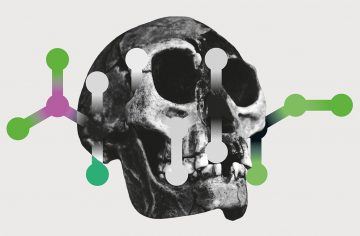Matthew Warren in Nature:
 Some time in the past 160,000 years or so, the remains of an ancient human ended up in a cave high on the Tibetan Plateau in China. Perhaps the individual died there, or parts were taken there by its kin or an animal scavenger. In just a few years, the flesh disappeared and the bones started to deteriorate. Then millennia dripped by. Glaciers retreated and then returned and retreated again, and all that was left behind was a bit of jawbone with some teeth. The bone gradually became coated in a mineral crust, and the DNA from this ancient ancestor was lost to time and weather. But some signal from the past persisted.
Some time in the past 160,000 years or so, the remains of an ancient human ended up in a cave high on the Tibetan Plateau in China. Perhaps the individual died there, or parts were taken there by its kin or an animal scavenger. In just a few years, the flesh disappeared and the bones started to deteriorate. Then millennia dripped by. Glaciers retreated and then returned and retreated again, and all that was left behind was a bit of jawbone with some teeth. The bone gradually became coated in a mineral crust, and the DNA from this ancient ancestor was lost to time and weather. But some signal from the past persisted.
Deep in the hominin’s teeth, proteins lingered, degraded but still identifiable. When scientists analysed them earlier this year, they detected collagen, a structural support protein found in bone and other tissues. And in its chemical signature was a single amino-acid variant that isn’t present in the collagen of modern humans or Neanderthals — instead, it flagged the jawbone as belonging to a member of the mysterious hominin group called Denisovans1. The discovery of a Denisovan in China was a major landmark. It was the first individual found outside Denisova Cave in Siberia, where all other remains of its kind had previously been identified. And the site’s location on the Tibetan Plateau — more than 3,000 metres above sea level — suggested that Denisovans had been able to live in very cold, low-oxygen environments.
But the finding also marked another milestone: it was the first time that an ancient hominin had been identified using only proteins. It is one of the most striking discoveries yet for the fledgling field of palaeoproteomics, in which scientists analyse ancient proteins to answer questions about the history and evolution of humans and other animals. Proteins, which stick around in fossils for much longer than DNA does, could allow scientists to explore whole new eras of prehistory and use molecular tools to examine bones from a much broader part of the world than is currently possible, according to the field’s proponents.
More here.
